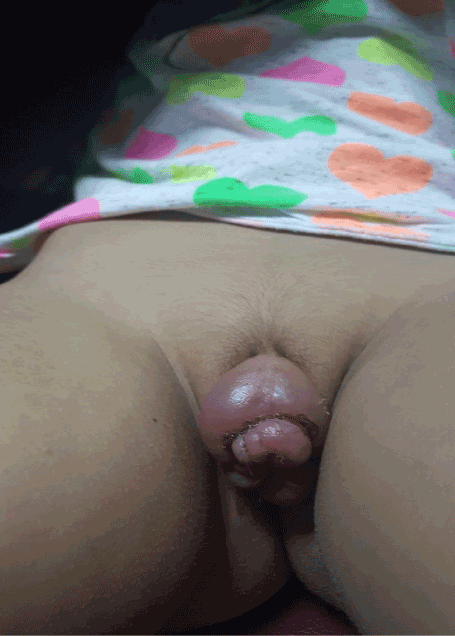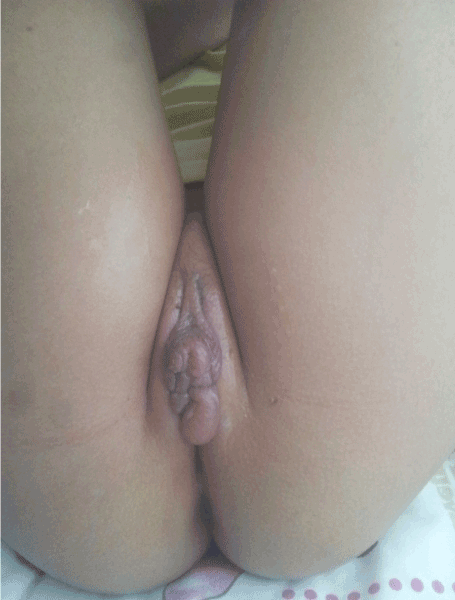Key words
Blunt/penetrating trauma, diaphragmatic rupture, diaphragmatic hernia, complication.
Introduction
Hair tourniquet syndrome (HTS) ia a rare clinical phenomenon. In this condition, a body appendage is tightly and circumferentially wrapped by hair, thread or similar material. Commonly affected sites include fingers, toes and genitals. Prompt diagnosis and treatment of this condition is vital to attain good outcome and prevent even a catastrophic consequence of autoamputation in affected body part. We here report a case of HTS involving genitalia in a 8-year-old girl. It is also aimed in this report to review current information about management of HTS in the light of relevant literature.
Case
A previously healthy 8-year-old girl was admitted to our clinic with a complain of severe pain and a swollen vulva of 3 days' duration. On physical examination she was otherwise normal. In the perineum, labia majora and clitoris was found to be swollen and edematous and hair strangulation at the base of the clitoris was detected (Figure 1). After excision and removal of the strangulating hair, the pain was relieved and edematous discoloration disappeared dramatically. Local treatment with antibiotic ointment was continued for 5 days after excision. On follow-up exam 7 days later, the anatomy of the genitalia had returned to normal (Figure 2).

Figure 1. Preoperative view showing the encircling hair at the base of clitoris. (Arrow: encircling hair).

Figures 2. Postoperative view 3 days after removal of the hair. The patient is under local treatment with antibiotic ointment.
Discussion
HTS is an uncommon acquired condition where appendages are strangulated by an encircling strand of hair, a thread, or a fiber [1]. First description of a tissue strangulated by a thread of hair was in 1612 by Guillimeau and the first documented report of this condition was published in Lancet in 1832 [2,3].
There are a number of pseudonyms used for definition of this clinical entity. These are namely tourniquet syndrome, toe tourniquet syndrome, hair thread tourniquet syndrome, hair tourniquet syndrome, hair coil strangulate syndrome or acquired constriction ring syndrome [4,5]. Essentially, any appendage may be involved by this disease. Commonly affected parts of the body include fingers, toes and penis [6,7]. It has also been reported that other body parts including clitoris, labia, ear lobes, umbilicus, nipple, tongue or uvula may be involved by this disease [1,8-13]. In a meta-analysis comprising 210 cases of HTS, 44.2% involved penis, 40.2% the toes, 8.6% fingers and 6.8% represented other sites [1].
Most cases of HTS occur in young children. Observed age range of reported cases with finger HTS is between first days of life up to 19 months and penile involvement is 4 months to 6 years [14]. Labial and clitoral wrapping have been described in an older age group (age 7-13 years) [15]. Concerning the age at presentation, the presented case in this report with an age of 8 years is similar to those reported previously [15,16].
The high tensile strength of hair makes it an effective tourniquet and humidification of the hair has an effcet on the tensile strength [4]. When wet, hair stretches out, and when dry it constricts back to its normal size. Thus if a hair is wrapped around and appendage, it may cause strangulation of the affected appendage when it dries [17]. In pathopysiological point of view, first constricting hair results in reduced venous and lymphatic drainage causing edema. If untreated, raised interstitial pressure may reduce arterial supply, causing ischaemia of the affected body part. Delay in diagnosis and treatment may cause catastrophic consequence of autoamputation of the involved part of the body and this process can occur over hours to weeks [2,18]. Prompt recognition and timely management of these cases is important to prevent loss of function or autoamputation of the in volved appendage [19,20].
Differential diagnosis of HTS includes infection, trauma, insect bite, allergic or irritant dermatitis, palmoplantar keratoderma and congenital constriction bands [4]. Child abuse, ainhum (digital annular constriction affecting a toe), pseudoainhum and paronychia should also be considered in the differential diagnosis [4,5]. As a one of the predisposing factors in HTS, "teleogen effluvium" deserves special attention. During postpartum period, 90% of mothers experience excessive hair loss called teleogen effluvium due to maternal hormonal changes [21]. This situation subsequently exposes their infants to the risk of HTS. It has been reported that the children with HTS due to teleogen effluvium are typically younger than 4 months [21].
Removal of the offending fiber as soon as possible is the corner stone in the treatmet of these patients. Reported techniques of surgical intervention include unwrapping method in cases with minimal edema, cutting of encircled hair with scissors or scalpel blade. Although its usage is off-label, use of depilatory creams has been reported to be safe alternative to instrumentation with minimal discomfort [22]. Cases requiring surgical debridment have also been reported for the treatment of late diagnosed patients with HTS [1,23]. Under local anesthesia with topical prilocain, hair coil was easily removed by a clamp and scissors from the genitalia of our patient and edema resolved dramatically after the procedure.
HTS is a rare disorder and it is frequently a diagnostic dilemma for the front liners of medical providers. It should be considered in the differential diagnosis of swollen appendages and the clinicians dealing with these children should be aware of this uncommon entity. HTS is a preventable and treatable condition if diagnosed early and managed appropriately. To avoid constrictive injury such as ischeamia and autoamputation of the involved body part, prompt recognition and timely treatment is a necessity rather than of choice and may prevent decapitating injuries.
Disclosure
The authors declare no conflicts of interest.
References
- Mat Saad AZ, Purcell EM, McCann JJ (2006) Hair-thread tourniquet syndrome in an infant bony erosion: a case report, literature review, and meta-analysis. Ann Plast Surg; 57(4): 447-52.
- Kuo JH, Smith LM, Berkowitz CD (2002) A hair tourniquet resulting in strangulation and amputation of the clitoris. Obstet Gynecol 99: 939-941. [Crossref]
- Klusmann A, Lenard HG (2004) Tourniquet syndrome--accident or abuse? Eur J Pediatr 163: 495-498. [Crossref]
- Sivathasan N, Vijayarajan L (2012) Hair-thread tourniquet syndrome: a case report and literature review. Case Rep Med 2012: 171368. [Crossref]
- Gulaçti U, Borta T, Çelik M, Aktas N, Buyuksalan H (2016) Hair-thread tourniquet syndrome: a presentation of an infant. Arc Cas Rep C Med; 2(3): 1-2.
- Golshevsky J, Chuen J, Tung PH (2005) Hair-thread tourniquet syndrome. J Paediatr Child Health 41: 154-155. [Crossref]
- Lohana P, Vashishta GN, Price N (2006) Toe-tourniquet syndrome: a diagnostic dilemma! Ann R Coll Surg Engl 88: W6-8. [Crossref]
- Flores JR (2014) Hair tourniquet syndrome in the dental patient. Anesth Prog 61: 111-112. [Crossref]
- Peckler B, Hsu CK (2001) Tourniquet syndrome: a review of constricting band removal. J Emerg Med 20: 253-262. [Crossref]
- Schneider K, Kennebeck S, Madden L, Campbell A (2013) Hair tourniquet of the circumvallate papillae: a potentially "hairy" situation. Pediatr Emerg Care 29: 924-925. [Crossref]
- Hickey BA, Gulati S2021 Copyright OAT. All rights reservuet syndrome in a four-year-old boy. J Emerg Med 44: 358-359. [Crossref]
- Dua A, Jamshidi R, Lal DR (2013) Labial hair tourniquet: unusual complication of an unrepaired genital laceration. Pediatr Emerg Care; 29(7): 829-30.
- Alverson B (2007) A genital hair tourniquet in a 9-year-old girl. Pediatr Emerg Care 23: 169-170. [Crossref]
- Barton DJ, Sloan GM, Nichter LS, Reinisch JF (1988) Hair-thread tourniquet syndrome . Pediatrics 82: 925-928. [Crossref]
- Bacon JL, Burgis JT (2005) Hair thread tourniquet syndrome in adolescents: a presentation and review of the literature. J Pediatr Adolesc Gynecol 18: 155-156. [Crossref]
- Pomeranz M, Schachter B, Capua T, Beyth Y (2009) Hair-thread tourniquet syndrome of labia minor. J Pediatr Adolesc Gynecol 22: e111-113. [Crossref]
- Summers JL, Guira AC (1973) Hair strangulation of the external genitalia: report of two cases. Ohio State Med J 69: 672-673. [Crossref]
- Sunil TM (2001) The hair-thread-tourniquet syndrome- report of an unusual presentation of this rare condition. Hand Surgery; 6(2): 231-3.
- Srinivasaiah N, Yalamuri RR, Vetrivel SS, Irwin L (2008) Limb tourniquet syndrome-A cautionary tale. Injury Extra; 39(4): 140-2.
- Corazza M, Carlà E, Altieri E, Virgili A (2002) What syndrome is this? Tourniquet syndrome. Pediatr Dermatol 19: 555-556. [Crossref]
- Strahlman RS (2003) Toe tourniquet syndrome in association with maternal hair loss. Pediatrics 111: 685-687. [Crossref]
- O'Gorman A, Ratnapalan S (2011) Hair tourniquet management. Pediatr Emerg Care 27: 203-204. [Crossref]
- Okeke LI (2008) Thread embedded into penile tissue over time as an unusual hair thread tourniquet injury to the penis: a case report. J Med Case Rep 2: 230. [Crossref]


